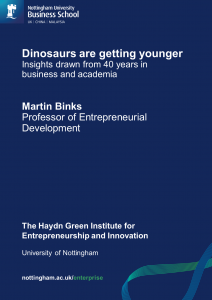
October 2, 2020, by aczjb1
Insights from 40 years in Business and Academia – Professor Martin Binks
Martin Binks has worked in academia and business since the late 1970s, and served as the Dean of Nottingham University Business School for a number of years. Now an Emeritus Professor, Martin has written a series of essays entitled ‘Dinosaurs are getting younger: Insights drawn from 40 years in business and academia’, drawing on his experiences to provide a range of insights into a series of important and interrelated issues concerning business school education and business itself.
The essays touch on a plethora of topics, including leadership and management, decision-making, trust and empathy, innovation, entrepreneurship, experiential learning and curriculum design.
You can read excerpt from the collection and download the full document below.
Using our ingenuity
We need to generate large numbers of solution ideas rapidly, without dwelling on or developing any individual possibility since this will simply distract us from ideas generation to idea development. We want large numbers of barely considered ideas. Having generated a large number of possibilities or ‘what ifs’ the process then requires a method of selection to combine and refine ideas until we reach the best.
This summary of the main three stages of systematic consideration and problem definition, solutions generation and final selection are not unduly challenging or onerous to undertake. In practice it is often mentally very stimulating, enjoyable and sometimes very funny and entertaining. We often enjoy being creative once we have overcome our underlying suspicion that we are not members of some select band of ‘creatives’. Everyone is creative most of the time. There are a variety of models that have been developed and proven to support individuals or groups who are seeking novel solutions to particular problems. At the University of Nottingham, for example we have developed the ‘Ingenuity’ process and ‘Ingenuity Online’ by building on and extending previous developments in creative problem solving that have evolved over generations. From our own applications of this approach and the work of others using similar methods we can demonstrate the clear and often significant benefits of a more careful consideration of the ‘what ifs’ prior to committing to a particular decision. Why then do so few of those who accept and are well aware of these benefits fail to continue to apply this relatively accessible and straightforward approach to complex problems in practice, (and I include myself in this counterintuitive behaviour)?
Consider some of the main possible explanations. One could be the fact that the return on time invested in creative problem solving is unpredictable. There is clear evidence that it can be very high but as yet no statistical analysis to indicate the probability of that being the case. It is also difficult to make valid comparisons between the outcomes of decisions based on creative problem solving and those resulting from a more pragmatic approach. This uncertainty makes it easier for the lazier of us to follow our instincts or do what we did before or simply copy the responses of others confronting the same problem.
An alternative explanation could be concern, or indeed fear, of the possible outcomes in terms of the disruption, changes and innovation that novel insights might indicate are now required. The same uncertainty that can be used in an attempt to justify lazier decision-making processes also applies to the repercussions that might arise from a radically different insight that creative problem solving might produce. There is a very natural temptation to adopt a ‘head in the sand’ approach due to fear of the unknown and fear of difference. Conformity and comfort zones are often preferred to unknown alternatives. The very term ‘radical’ sounds dangerously close to revolutionary and really can be quite unsettling. Well-designed and robust creative problem solving processes may be very effective at unleashing the insights that make for very difficult decisions when it comes to implementation. The combination of laziness and fear creates a powerful barrier to change and innovation. The resistance to change that this causes will grow as the sense
of foreboding that more radical interventions may be required in the future grows. Problems arising from population growth, pollution and resource depletion, for example, are unlikely to be solved through incremental innovation. Arguments to encourage radical innovation are not restricted to the preference to avoid apocalyptic demise. As Schumpeter argued, economic development is caused by and relies on radical transformational innovation rather than incremental improvement.
This brings us back to our natural resistance to using proven, effective creative problem solving processes to enhance our decision-making as well as providing a robust rationale for the decisions made. The sheer scale of the problems that we need to confront and the urgency that prevails in many cases render risibly absurd, arguments around the return on time invested in radical innovation thinking or qualms about the kinds of solution that might emerge. This leaves the possibilities of either a lack of awareness of radical innovation thinking approaches, or a distrust of their superiority to existing decision-making methods due to a fear of surrendering sovereignty over some of our most significant choices to what may be perceived as a formulaic process.

Dinosaurs – essays from Martin Binks
No comments yet, fill out a comment to be the first

Leave a Reply